Spring has sprung and so has the urge for spring cleaning. And while we all work from home anxiously waiting out the COVID-19 quarantine, there’s no time like the present to start procrasticleaning. Recently, Moment columnist Letty Cottin Pogrebin was pushed into a decluttering session of her own by her daughter Abigail. “It was a grueling ordeal,” she writes in “The Life-Changing Magic of Clutter,” “each object freighted with meaning and memories. I’m not materialistic, but I believe in the power of things to evoke people, places, days of one’s life.”
These words inspired us to launch the Jewish Objects Project, where we asked Moment readers to share photos and stories of things that inspire meaning and memories of their own. Below is a collection of some of our favorites.
Dan Freedman, 67
 This Hebrew Bible has my grandfather’s written notes on his family history, noting that his father became a U.S. citizen in 1910. It also includes names and birthdates of his grandchildren, written in Yiddish. I only discovered it in adulthood. After my parents died in 2011, this bible was the only link I had to my father’s father’s past. (This was before Ancestry.com changed everything.) This bible serves as a living link to my grandfather, who died in 1957 when he was about my age. I have very few memories of him, but this helps connect me to his world.
This Hebrew Bible has my grandfather’s written notes on his family history, noting that his father became a U.S. citizen in 1910. It also includes names and birthdates of his grandchildren, written in Yiddish. I only discovered it in adulthood. After my parents died in 2011, this bible was the only link I had to my father’s father’s past. (This was before Ancestry.com changed everything.) This bible serves as a living link to my grandfather, who died in 1957 when he was about my age. I have very few memories of him, but this helps connect me to his world.
Linda K. Wertheimer, 55
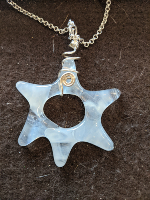 I cried the day I received this pendant in the mail from an old friend of mine, Dee, who is Christian, and grew up across the street from me in Findlay, OH. I had experienced anti-Semitism in our school and had written about it and my journey becoming closer to my Jewish faith because of those experiences. Dee, now a stained glass artist, read one of my essays and was moved. She made me her first piece of Judaica, a Star of David, and sent it to me in the mail. She wanted me to know how precious I was to her as a friend and how sorry she was about the way some of our peers treated me and my brothers in our rural Ohio school system. Every time I wear this pendant, it is a bittersweet moment. I think of the pain I felt when kids teased me about my Jewishness during childhood but I also think of the love my friend Dee showed when she made it for me. I think, too, of the respect she showed for my faith.
I cried the day I received this pendant in the mail from an old friend of mine, Dee, who is Christian, and grew up across the street from me in Findlay, OH. I had experienced anti-Semitism in our school and had written about it and my journey becoming closer to my Jewish faith because of those experiences. Dee, now a stained glass artist, read one of my essays and was moved. She made me her first piece of Judaica, a Star of David, and sent it to me in the mail. She wanted me to know how precious I was to her as a friend and how sorry she was about the way some of our peers treated me and my brothers in our rural Ohio school system. Every time I wear this pendant, it is a bittersweet moment. I think of the pain I felt when kids teased me about my Jewishness during childhood but I also think of the love my friend Dee showed when she made it for me. I think, too, of the respect she showed for my faith.
After the Tree of Life shootings in October 2018, I wore this star to Shabbat services at our temple the next Friday. I wanted to wear the biggest most visible Star of David I had. I also wanted to find one that represented hope. For when a non-Jew stands up against anti-Semitism, it means everything.
Merri Ukraincik, 53
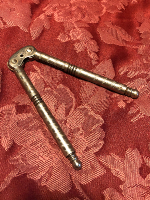 This was my grandmother’s nutcracker. She gave it to me a few months after my husband and I married, though she hadn’t had the strength to make Passover for years already. I didn’t take the moment lightly. This was the passing down of a tradition, and I understood the obligation that came with it. But I also knew how lucky I was that my grandmother had chosen me. It’s the first thing I take out of storage each year when I begin preparing our kitchen for the holiday. And though I haven’t had to use it since she bequeathed it to me—thank God for the bags of shelled walnuts available in the Passover aisle— it wouldn’t be Pesach without it.
This was my grandmother’s nutcracker. She gave it to me a few months after my husband and I married, though she hadn’t had the strength to make Passover for years already. I didn’t take the moment lightly. This was the passing down of a tradition, and I understood the obligation that came with it. But I also knew how lucky I was that my grandmother had chosen me. It’s the first thing I take out of storage each year when I begin preparing our kitchen for the holiday. And though I haven’t had to use it since she bequeathed it to me—thank God for the bags of shelled walnuts available in the Passover aisle— it wouldn’t be Pesach without it.
One of my favorite Passover memories is of My grandmother, mother, sister, and I positioned at the kitchen table a few days before the first seder, encircling a mountain of whole walnuts as if we’re seated around a campfire. We tell tales and share memories while dismantling the hard shells with unwieldy nutcrackers. There are several, so we can all stay on task. It takes hours for us to finish the job. By the time we crack the last shell, our fingers bear the cuts and scars of our labors. But it’s always worth it because these nuts make possible the charoset and nut tortes that sweeten both the holiday and my long-term memories.
Now, I place my grandmother’s nutcracker in our kitchen window to watch over me while I cook. Someone always comments when they see it there, wondering why I haven’t tossed such an ancient relic I’ll never use again. But I love the happy family story it represents. I treasure the sense of belonging I felt at the kitchen table—to the women I grew up with, to my Judaism, to me. It’s something I’ve carried with me ever since, and the nutcracker reminds me of it whenever I feel the joy in that memory slipping through my hands.
Hannah Boyd, 45
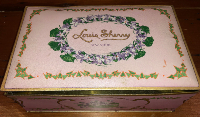 Is this a Jewish object? It first belonged to my great-grandfather, who liked candy so much that, given the dental standards of the time, he lost all his teeth. By the time I came along, his empty candy tin had become my grandmother’s sewing box, overflowing with spare buttons and spools of thread. The domed lavender box decorated with purple flowers and “Louis Sherry” in swirling gilt letters hinted at treasure, the stuffed tomato bristling with straight pins no substitute for the mysterious chocolates of days past.
Is this a Jewish object? It first belonged to my great-grandfather, who liked candy so much that, given the dental standards of the time, he lost all his teeth. By the time I came along, his empty candy tin had become my grandmother’s sewing box, overflowing with spare buttons and spools of thread. The domed lavender box decorated with purple flowers and “Louis Sherry” in swirling gilt letters hinted at treasure, the stuffed tomato bristling with straight pins no substitute for the mysterious chocolates of days past.
My grandmother had slim, elegant hands, and she loved to sew and needlepoint. When her eyesight became too poor for needlework, she gave me the box. Its golden interior and lettering matched the colors my daughter chose for her bat mitzvah decor, so we put the box on a table to hold cards. My grandmother, raised “classical Reform,” hadn’t had a bat mitzvah; the Hebrew school my mother attended as a girl offered confirmation instead. My parents never belonged to a congregation. I came to religion as an adult, so my daughter’s bat mitzvah was a milestone for us all—a symbol of return. When someone urged my grandmother to stay healthy so she could reach her 100th birthday that summer, she said, “I don’t need that—I just need to make it to that bat mitzvah.” And she did, and her father’s box was there too. So to me, yes, it is a Jewish object. L’dor v’dor.
I decided to research Louis Sherry Chocolates while writing this piece and found that the company is still in business, and still selling chocolates in the exact same tin (although I doubt my great-grandfather’s box contained Sicilian Orange and Sea Salt Caramel truffles). Far from being the small, Cleveland-based business I’d imagined, Louis Sherry is a remnant of the Gilded Age, currently sold in stores like Neiman Marcus and Bloomingdale’s. No wonder my great-grandfather saved the box—this must have been quite an extravagance for him. I know my grandmother would have been tickled to encounter a perfect, shiny, undented version, but this battered old tin and the memories it holds are my favorites.
Luisa Moss, 39
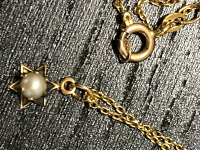 I found this in my grandmother’s jewelry box as we were getting ready to help her move to a nursing home. I was heading to college for my freshman year. I wear it every day to remind me of her and my commitment to Judaism.
I found this in my grandmother’s jewelry box as we were getting ready to help her move to a nursing home. I was heading to college for my freshman year. I wear it every day to remind me of her and my commitment to Judaism.
Jane S. Gabin
 One of my favorite memories of this object is dad telling the story of how he acquired the star. I didn’t learn about this until I was an adult. My father was in the US Army in Paris, in a postal unit. That meant he was stationed there for quite a long time, almost two years. He would buy everything he was entitled to—food, household items like soap—and would give it away to Jewish civilians he met. After this time, the Army sent him to Frankfurt, and we went to bid farewell to the families he had befriended. The father in one family wanted to give my dad a present and offered him jewelry. Dad would not take that, so the man said, “Then you must take this,” and gave him the star.
One of my favorite memories of this object is dad telling the story of how he acquired the star. I didn’t learn about this until I was an adult. My father was in the US Army in Paris, in a postal unit. That meant he was stationed there for quite a long time, almost two years. He would buy everything he was entitled to—food, household items like soap—and would give it away to Jewish civilians he met. After this time, the Army sent him to Frankfurt, and we went to bid farewell to the families he had befriended. The father in one family wanted to give my dad a present and offered him jewelry. Dad would not take that, so the man said, “Then you must take this,” and gave him the star.
I keep the star in a frame with a photo of my father in uniform. But I could KICK myself for not asking my father more questions when he was alive. What was the name of these people? On what street in Paris did they live? How had they managed to evade the various round-ups that the police conducted? Did you stay in touch with them after you left Paris? This is something I will pass down to my daughter and her children.
Ellen Sazzman, 68
 Corseted waists alternate with swelling breasts and bellies, their weight borne on wide-hipped bases. The twinned silver candlesticks are graceless but for their century-old history. The pair stand proud but voiceless as my own mother who belatedly surrendered them to me. Every Friday night my mother and I polished the hammered metal and made the blessing. Now I lift each candlestick and caress. The mirrored surface reflects my mother’s molten eyes, and I attempt to intone the blessing so strong as to kindle our matriarchs’ voices. They shimmer, sweet wine anointing the light.
Corseted waists alternate with swelling breasts and bellies, their weight borne on wide-hipped bases. The twinned silver candlesticks are graceless but for their century-old history. The pair stand proud but voiceless as my own mother who belatedly surrendered them to me. Every Friday night my mother and I polished the hammered metal and made the blessing. Now I lift each candlestick and caress. The mirrored surface reflects my mother’s molten eyes, and I attempt to intone the blessing so strong as to kindle our matriarchs’ voices. They shimmer, sweet wine anointing the light.
Susan Rosenbluth, 73
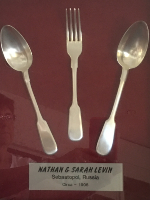 My grandparents took this set of flatware with them to America from Sebastopol (sometimes called Sevastopol) on the Black Sea in Ukraine, Russia. They were handed down from my grandparents, Nathan and Sarah Levin, to the only one of their three daughters (my aunts) who lived near them in Atlantic City, NJ. This aunt gave them to one of her daughters (my cousin), who placed them in a boxed frame with a red velvet background and presented them to my father for his 70th birthday in 1986. When my mother died in 2016, the utensils in their frame went to me.
My grandparents took this set of flatware with them to America from Sebastopol (sometimes called Sevastopol) on the Black Sea in Ukraine, Russia. They were handed down from my grandparents, Nathan and Sarah Levin, to the only one of their three daughters (my aunts) who lived near them in Atlantic City, NJ. This aunt gave them to one of her daughters (my cousin), who placed them in a boxed frame with a red velvet background and presented them to my father for his 70th birthday in 1986. When my mother died in 2016, the utensils in their frame went to me.
Earlier this year, my 12-year-old granddaughter, Devorah, wanted to know more about these utensils. I explained to her that they were given to Nathan and Sarah Levin, her great-great-grandparents, by Sarah’s mother, Malka Irow, who was Devorah’s great-great-great-grandmother. Then I told my granddaughter more about the town of Sebastopol, the largest city on the Crimean Peninsula and a major port on the Black Sea, where Nathan was a furrier, and how he and Sarah and their three children made the voyage not to New York, like so many other Jewish immigrants did, but to Philadelphia, because that was closer to the destination they had pre-selected, the coal-mining town of Hazelton, PA, in the Pocono Mountains, where Sarah’s older sister was already living. Nathan, however, was not particularly interested in living in the mountains. When he heard that Philadelphia was only 60 miles from Atlantic City, NJ, where there was a Jewish community and he could live by the ocean, he knew that is where the Levin family would go. And so they did, and, in Atlantic City, they had three more children. In 1913, they opened Nathan Levin Furs, where he worked until he died in 1949, and was followed into the business by first his son, my father, and then my brother. I took this photo of the utensils and hope Devorah, as well as her two brothers and nine cousins (all our grandchildren), will enjoy looking at them as much as I enjoy telling the story.
David E. Cohen
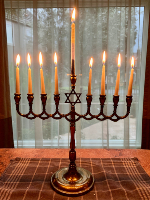 This menorah followed me to college and through my life. I gave each son a menorah of their own. I remember lighting the candles with my two young sons and telling them the menorah was given to me when I was very young by their grandma and grandpa.
This menorah followed me to college and through my life. I gave each son a menorah of their own. I remember lighting the candles with my two young sons and telling them the menorah was given to me when I was very young by their grandma and grandpa.
Diana Rosen, 75
 The tallis bag and the tallis it holds, are a sweet memory of my father. The tallis has yellowed in the folds over these many years, and the bag itself is from his bar mitzvah, now 92 years old. (He would have been 105 years old in 2020 had he not died when he was the proverbial 70+13.) Of all the memories it brings me, the most vivid is how, awakened early by a phone call many days, Dad would grumble, dress quickly, grumble, grab his tallis bag, and go to complete the minyan at his hometown shul.
The tallis bag and the tallis it holds, are a sweet memory of my father. The tallis has yellowed in the folds over these many years, and the bag itself is from his bar mitzvah, now 92 years old. (He would have been 105 years old in 2020 had he not died when he was the proverbial 70+13.) Of all the memories it brings me, the most vivid is how, awakened early by a phone call many days, Dad would grumble, dress quickly, grumble, grab his tallis bag, and go to complete the minyan at his hometown shul.
He never said no. Owning a record store opened from 9 am to 9 pm six days a week, my dad coveted those few extra minutes of sleep each morning, so that’s why he grumbled.
I never asked him why he went, it seemed obvious to me even as a child that there are some duties that must always be fulfilled. Did this make dad a better Jew? Not really. Did it make him more religious? Definitely not. He was, in many ways, a Jewish agnostic often quoting Marx’s axiom that religion was the opiate of the masses while, at the same time, giving my sister and me a genuine Jewish education at shul and at home with all the traditions and ceremonies and knowledge that implies.
Was his reason more than being dutiful to this ancient tradition? Was it the definition of being a man his bar mitzvah declared him to be? I think so; this is what a man does. He contributes. He fulfills his obligations. He shows up when it counts. And, to continue the nearly six thousand-year-old thread of Torah reading, what better mitzvah is there?
I acknowledge that some synagogues allow women to participate in minyans these days (hooray!) and my comments mean them no disrespect.
Hope Lockwood, 19
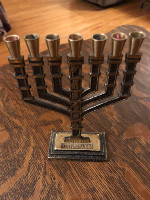 This non-Hanukkah menorah is made from heavy bronze metal and is pretty plain except for two labels: one that reads Jerusalem and the other that reads יְרוּשָׁלַיִם. My late grandfather who passed away when I was five bought it on his trip with my parents to Israel. It sits on our designated “Jew” shelf alongside our Hanukkah menorahs, various scrolls, dreidels, the mezuzah from our old house and of course, a stockpile of maybe four boxes of candles.
This non-Hanukkah menorah is made from heavy bronze metal and is pretty plain except for two labels: one that reads Jerusalem and the other that reads יְרוּשָׁלַיִם. My late grandfather who passed away when I was five bought it on his trip with my parents to Israel. It sits on our designated “Jew” shelf alongside our Hanukkah menorahs, various scrolls, dreidels, the mezuzah from our old house and of course, a stockpile of maybe four boxes of candles.
My favorite memory with the menorah is of my parents showing me how to light it. We didn’t have any candles that fit it so we used those cheap little yellow, pink and blue birthday candles.
Ruth Radwin, 15
 I don’t remember how long I had the kippah for, or where it came from. My family has always had an immense collection of kippot, collected from bar mitzvahs and weddings, but mine always stood out. I had never seen another person wearing one like it, and I was always excited to wear it. Then, in 7th grade, the kippah was lost at one of the many bar mitzvah parties. I was so sad, as my own bat mitzvah was coming up, and now I wouldn’t have my special kippah. Then, my mother had an idea. What if instead of getting the standard monochromatic kippot all the other kids had for their bnei mitzvot, we gave out watermelon kippot? After a little searching on the internet, we managed to find some in bulk. When the day of my bat mitzvah came, I was so excited to see everyone wearing watermelon kippot. To this very day, I still see people at our shul wearing the kippot, and it makes me so happy that they could share in my simcha.
I don’t remember how long I had the kippah for, or where it came from. My family has always had an immense collection of kippot, collected from bar mitzvahs and weddings, but mine always stood out. I had never seen another person wearing one like it, and I was always excited to wear it. Then, in 7th grade, the kippah was lost at one of the many bar mitzvah parties. I was so sad, as my own bat mitzvah was coming up, and now I wouldn’t have my special kippah. Then, my mother had an idea. What if instead of getting the standard monochromatic kippot all the other kids had for their bnei mitzvot, we gave out watermelon kippot? After a little searching on the internet, we managed to find some in bulk. When the day of my bat mitzvah came, I was so excited to see everyone wearing watermelon kippot. To this very day, I still see people at our shul wearing the kippot, and it makes me so happy that they could share in my simcha.
Cheryl Dronzek, 59
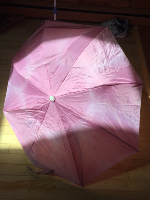 My father gave me this pink umbrella when I graduated and began my first real job. Pink is so not my color! My father knew I wasn’t typically feminine, but I think he wanted to remind me that I would always be the baby girl of the family. Despite my discomfort with the color, I used it and remembered him giving it to me every time I opened it. Using it was like having my father hold my hand. I kept it for 38 years, even though it broke after 15.
My father gave me this pink umbrella when I graduated and began my first real job. Pink is so not my color! My father knew I wasn’t typically feminine, but I think he wanted to remind me that I would always be the baby girl of the family. Despite my discomfort with the color, I used it and remembered him giving it to me every time I opened it. Using it was like having my father hold my hand. I kept it for 38 years, even though it broke after 15.
Arielle Gordon, 21
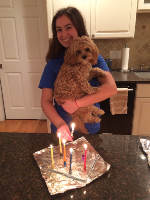 I purchased this chanukiah during my bat mitzvah trip to Israel. We were walking along a small street and looking for gifts for our friends at home. I saw it in a store window and knew immediately that I needed to see it up close. I fell in love with it and knew that I would use it each year. The people in the store were very friendly and we negotiated (with the help of my dad speaking Hebrew) the price down to within my budget. They wrapped it and it was mine to treasure forever. It gave us a good reason to also visit Tsfat to buy a box of candles to use when we got home.
I purchased this chanukiah during my bat mitzvah trip to Israel. We were walking along a small street and looking for gifts for our friends at home. I saw it in a store window and knew immediately that I needed to see it up close. I fell in love with it and knew that I would use it each year. The people in the store were very friendly and we negotiated (with the help of my dad speaking Hebrew) the price down to within my budget. They wrapped it and it was mine to treasure forever. It gave us a good reason to also visit Tsfat to buy a box of candles to use when we got home.
This item is meaningful to me because it reminds me of the time that I visited Israel with my family and celebrated my bat mitzvah. We use it each night during Chanukah, and taking the time each night to set it up and light it is very special to the whole family.
My favorite part of it is that each of the pieces that hold a candle is magnetic and so is the base. Each night, we rearrange the pieces to a new formation that is unique to the number of candles that we are lighting that night. It is fun to put a modern twist on such an important Jewish Object.
Dinah Rokach, 67
 My eight grade Hebrew Day school class crafted these 10″-long bookmarks to commemorate the class’ completing the Book of Deuteronomy. I have used it all these 55 years as a place-holder for my studies of the Holy Judaic texts. It is the perfect length with a beautiful passage from the Torah on each side. Life-long learning and re-learning of the same texts bring nuance and deeper understanding as one ages, even as the text and the bookmark remain unchanged.
My eight grade Hebrew Day school class crafted these 10″-long bookmarks to commemorate the class’ completing the Book of Deuteronomy. I have used it all these 55 years as a place-holder for my studies of the Holy Judaic texts. It is the perfect length with a beautiful passage from the Torah on each side. Life-long learning and re-learning of the same texts bring nuance and deeper understanding as one ages, even as the text and the bookmark remain unchanged.
Dina Gold
 I associate this painting of the world-famous violinist Yehudi Menuhin with my aunt who hung it in her house. I remember seeing it there and being aware of how emotionally attached she was to both the painting and the man. When Sheila died in 2012 the painting was passed to me.
I associate this painting of the world-famous violinist Yehudi Menuhin with my aunt who hung it in her house. I remember seeing it there and being aware of how emotionally attached she was to both the painting and the man. When Sheila died in 2012 the painting was passed to me.
Yehudi Menuhin needs little introduction. My aunt, Sheila Gold, worked closely with the maestro and traveled with him for many years. One of the proudest moments of her career was accompanying Yehudi to meet President Ronald Reagan at the White House in December 1986 on the occasion of the annual awards ceremony for the Kennedy Center Honors.
Michael Lieberman, 34
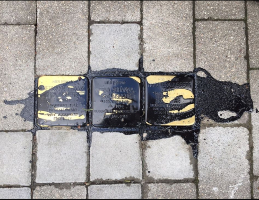 I always pick up this defaced Stolpersteine stone when I’m at my grandparents’ place in Miami. The weight of the stone in one’s hand imparts an incredible significance.
I always pick up this defaced Stolpersteine stone when I’m at my grandparents’ place in Miami. The weight of the stone in one’s hand imparts an incredible significance.
Stolpersteine stones are found throughout Europe; the project was initiated by Gunter Demnig to commemorate victims of the Holocaust. This particular stone was dedicated in honor of my grandmother’s father, Hermann Braunsberg, in the town of Frohburg, Germany in 2015—it was vandalized within months. To their credit, the town and mayor have been wonderful to the Braunsberg’s descendants. The vandalized stone was cleaned and given to the family while new stones were rededicated in 2016. In addition, the school in Frohburg has done an entire semester on patching together the history of my great-grandfather’s family and their relationship with the town. Of course, I have some mixed feelings about all of this. Germany will always be a complicated place and a well of emotion for my family. In a way, I wish they had left the original stones as they were—defaced with black tar by an ignorant person, who represents, without a doubt, a small minority in Frohburg. If it was up to me, the stone would remain caked in sludge on that sidewalk, a reminder that we are still living with this history and that we can continue to do better—to improve our empathy. We can be better neighbors.
Meri Harary, 50
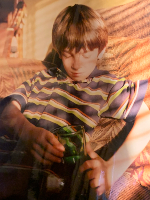
The photo of Meri Harary’s son with the goblet
My mother told me this green glass goblet belonged to her grandmother and was hand made in the 1800s. You can see the air bubbles in the class. She told me that it somehow made it here from Nazi Germany.
My great grandparents were killed in the Holocaust, but my grandmother somehow took the goblet with her when, after hiding in a friend’s house for a month with her husband and two young children, they were able to escape from Berlin to America in 1939. My mother treasured this goblet, that miraculously survived hiding in an attic in Berlin, being transported to America on a boat, being displayed on a shelf in several residences in Brooklyn and then in my mother’s house in Connecticut. When my mom passed away in 2018, I found it in her living room with a picture of my son holding it, stuck inside the goblet. My mother would hold it and say, “I never met my grandmother, because she died in the Holocaust, but her hands once held this goblet,” as she lovingly held the green glass. It now sits atop my mantel in my living room, photo still inside.

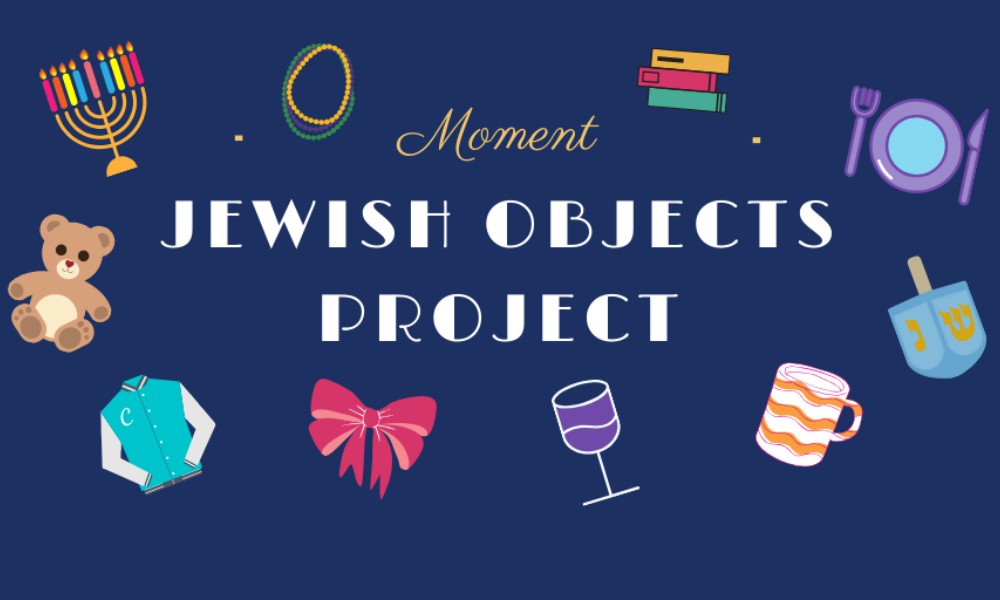
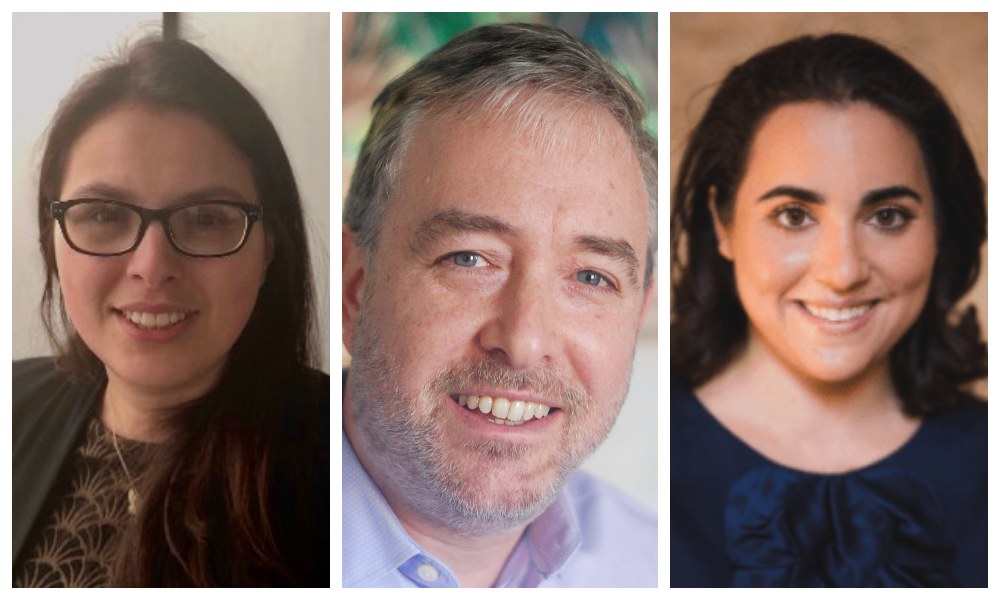
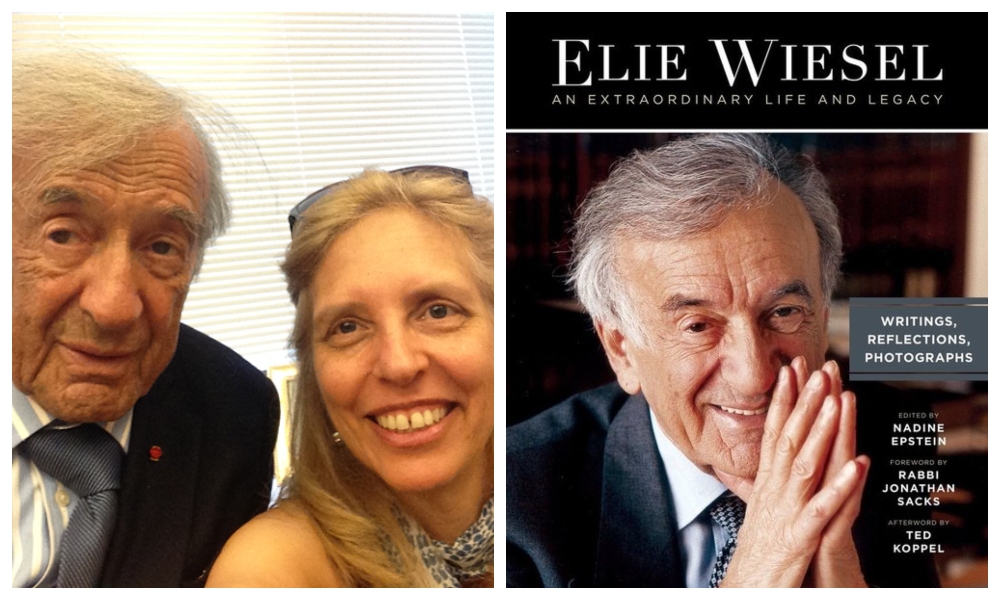
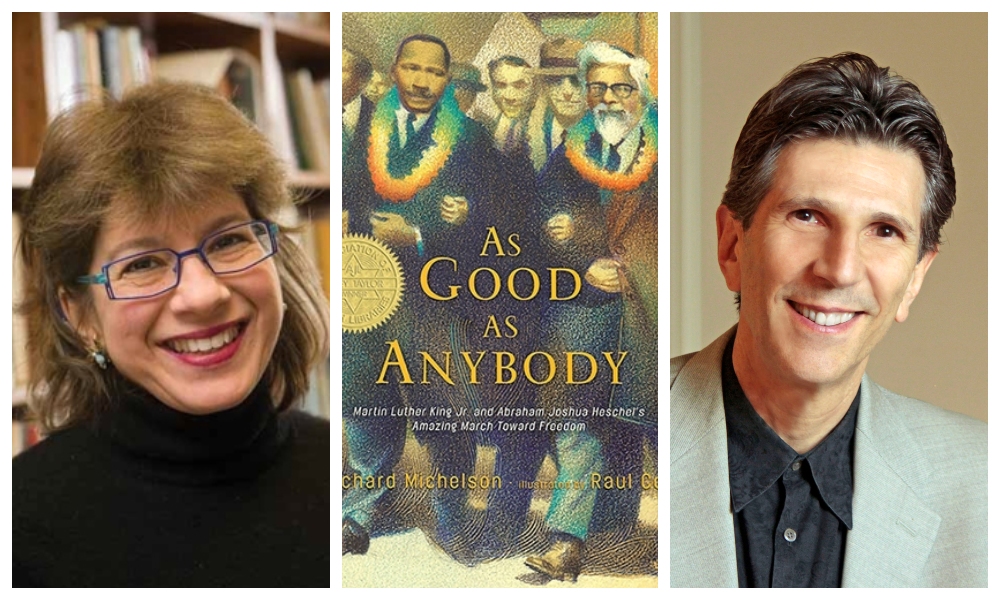
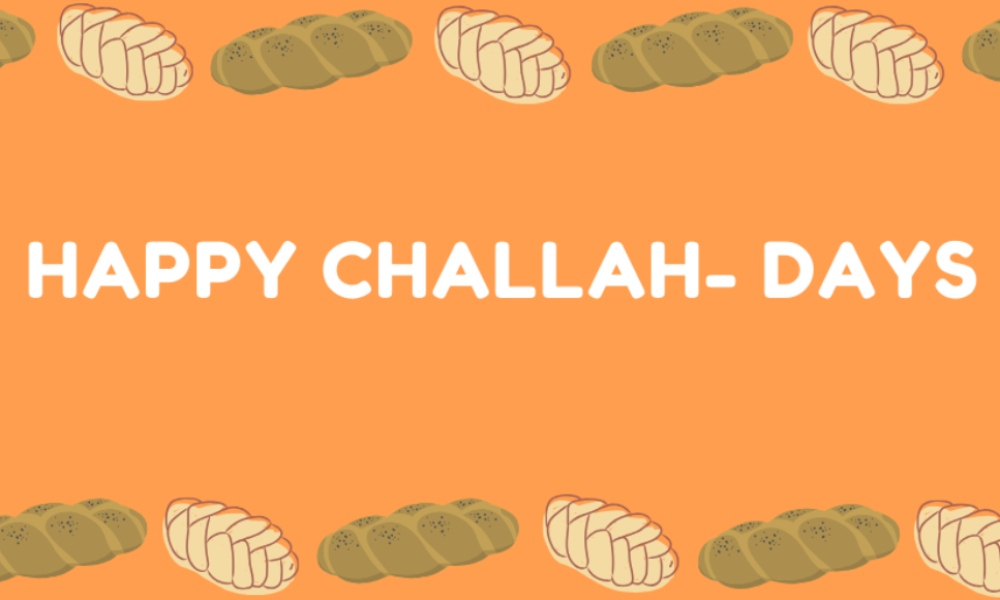


What a beautiful article. I’m honored to be part of it.